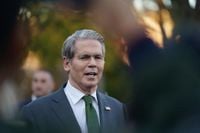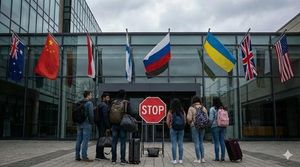After the recent end of the U.S. government shutdown on November 14, 2025, investors find themselves navigating a market landscape riddled with uncertainty. The abrupt halt to government operations left a trail of missing economic data, and the resulting data gaps have cast a long shadow over Wall Street’s ability to forecast the future. As the dust settles, the markets are grappling with fears that delayed or canceled Federal Reserve rate cuts could further destabilize an already jittery environment, especially given ongoing skepticism over the soaring valuations of artificial intelligence stocks.
On Thursday, November 13, the Nasdaq suffered its heaviest selloff in a month, a stark indicator of the unease permeating global markets. According to agency reports, blue-chip indices in Tokyo, Paris, and London also dipped sharply before managing a modest recovery. The mood among investors and policymakers alike has been summed up as “driving in the fog”—a phrase that captures the current dilemma as everyone waits for delayed economic data to shed light on the true state of the economy.
Friday brought a mixed close to Wall Street, with investors nervously eyeing Nvidia’s upcoming quarterly results scheduled for November 19. The market’s partial recovery after Thursday’s selloff was fragile, as all three major U.S. indexes had tumbled more than 1% at the open. The S&P 500 edged down by 2.70 points (0.05%) to finish at 6,734.42, while the Dow Jones Industrial Average dropped 308.29 points (0.65%) to 47,148.93. In contrast, the tech-heavy Nasdaq Composite managed to gain 29.17 points (0.13%) to close at 22,899.53, buoyed by renewed interest in AI-related stocks.
The performance of heavyweight technology firms has been a double-edged sword for the market. Nvidia, Palantir, Microsoft, and Tesla all posted gains on Friday, yet the very valuations that have fueled market optimism in recent years are now a source of anxiety. Investors are increasingly wary that the AI sector’s rapid ascent may not be sustainable—especially if the Federal Reserve holds off on cutting interest rates in December, a move that many had hoped would provide relief to risk assets.
Expectations for a December rate cut have faded noticeably in recent days. According to CME Group’s FedWatch tool, the probability of a 25-basis-point cut at the Fed’s upcoming policy meeting has dropped to under 50%, down from 67% just a week earlier. Persistent inflation, partly driven by President Donald Trump’s global tariffs, is a key factor behind the shift in sentiment. Kansas City Fed President Jeffrey Schmid voiced his concerns on Friday, stating that his worries about “too hot” inflation extend well beyond the immediate effects of tariffs. Schmid, one of two dissenters in the Fed’s October decision to lower the policy rate by a quarter of a percentage point, signaled that he could dissent again in December if policymakers opt to cut short-term borrowing costs. “My concerns about inflation go well beyond the narrow effects of tariffs,” Schmid said, making clear that the debate within the Fed is far from settled.
The labor market and inflation outlook remain top of mind for investors, who also fear that some gaps in official economic data may become permanent, even after the shutdown’s resolution. These missing data points are more than just a bureaucratic headache—they represent a critical blind spot for both policymakers and market participants trying to gauge the health of the world’s largest economy. As one market observer put it, “Driving in the fog” seems to be the only way forward for now.
Adding another layer of complexity, President Donald Trump has turned up the heat on Federal Reserve Chair Jerome Powell. Trump’s vocal and persistent criticism of Powell has become a fixture of the financial news cycle. According to recent reporting, Trump is positioning himself to select a new Fed chief more closely aligned with his own views in 2026. This looming personnel change injects additional uncertainty into the already fraught relationship between the White House and the central bank, raising questions about the future direction of U.S. monetary policy.
Meanwhile, the anticipation surrounding Nvidia’s quarterly earnings release is palpable. The AI chipmaker has become a bellwether for the broader market’s appetite for risk and innovation. “We’ve got a huge event next week with Nvidia,” said Mike Dickson, head of research and quantitative strategies at Horizon Investments in Charlotte, North Carolina. “If Nvidia disappoints, they will be punished. But I also think that—kind of like you’re seeing today—you’ll see dip buyers come back in pretty quickly and stabilize things.” The stakes are high, as investors are eager for fresh evidence that the race to dominate artificial intelligence technology is not losing steam.
Elsewhere in the market, a handful of notable corporate moves made headlines. Warner Bros Discovery saw its shares rise after the company announced an amendment to CEO David Zaslav’s employment agreement, part of a broader strategic review. In the pharmaceutical sector, Cidara Therapeutics shares doubled on news that Merck will acquire the company in a nearly $9.2 billion deal. On the international front, the Swiss government reported that U.S. tariffs on Swiss goods will be reduced to 15% from 39%, a development that could ease some trade tensions and provide relief to affected industries.
Despite these pockets of optimism, the overarching narrative remains one of caution and unpredictability. The combination of missing economic data, shifting Federal Reserve expectations, and political uncertainty has created a market environment where even seasoned investors are struggling to see the road ahead. The performance of AI stocks like Nvidia will likely set the tone for the coming weeks, but as the Fed debates its next move and the White House eyes changes at the top of the central bank, the only certainty is that the market’s current bout of “driving in the fog” is far from over.
For now, investors and policymakers alike are left waiting for clarity—hoping that the next wave of data, corporate earnings, and policy decisions will finally bring the market’s path into sharper focus.




